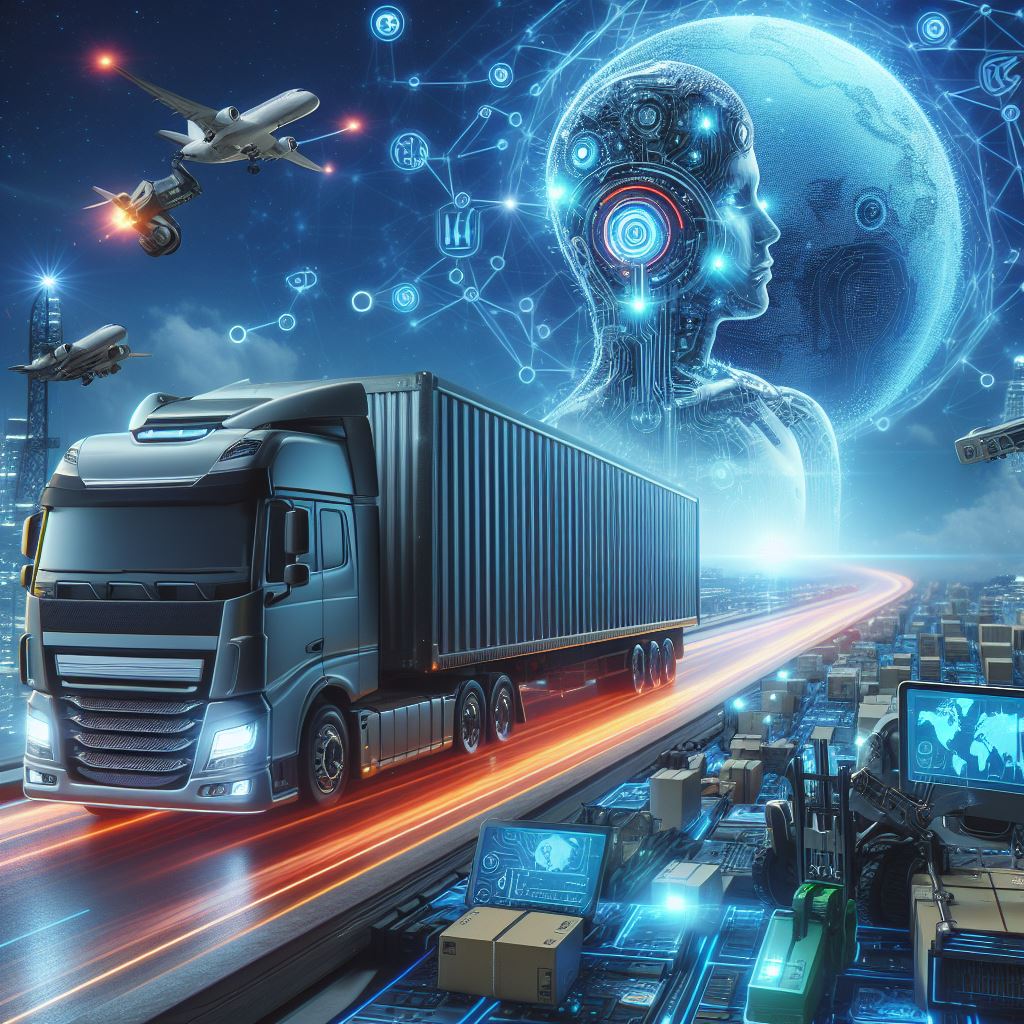Transforming Reverse Logistics: 4 AI Solutions You Need to Know
Reverse logistics refers to the process of moving goods from their final destination back to the manufacturer or supplier. It is becoming an increasingly critical component of the supply chain. Traditionally, logistics focused on efficiently moving products from production to consumers. However, as consumer expectations rise and environmental concerns grow, the importance of efficiently managing returns, repairs, and recycling has come to the forefront.
The growing importance of reverse logistics can be attributed to several factors:
- Consumer Expectations: Today’s consumers expect hassle-free returns and exchanges, which necessitates an effective reverse logistics system.
- Economic Impact: Businesses incur a significant cost due to returns and exchanges, so maintaining profitability requires efficient management of reverse logistics.
- Sustainability: With a global push towards sustainability, companies are under pressure to reduce waste and recycle more, requiring robust reverse logistics processes.
Enter artificial intelligence (AI), which is revolutionizing reverse logistics in several ways. AI technologies, such as machine learning, predictive analytics, and computer vision, are being employed to focus on various aspects of reverse logistics, including return predictions, inventory management, and process automation. By leveraging AI, companies can achieve greater efficiency, reduce costs, and improve customer satisfaction.
The benefits of integrating AI into reverse logistics include:
- Improved Efficiency: AI can automate and optimize the sorting, processing, and routing of returned goods, leading to faster turnaround times.
- Cost Reduction: By predicting return rates and optimizing inventory levels, AI can help companies reduce the financial impact of returns and exchanges.
- Boost Customer Experience: AI-powered recommendation engines and virtual try-on features can reduce return rates by helping customers make more informed purchasing decisions.
The role of AI in transforming reverse logistics is increasingly significant. As businesses strive to meet customer expectations and embrace sustainability, the integration of AI into reverse logistics processes is not just a trend but a necessity for future success.
AI Solutions in Reverse Logistics
The integration of artificial intelligence (AI) into reverse logistics offers a range of solutions that can significantly improve the efficiency and effectiveness of the entire process. Here are some key AI solutions that are transforming reverse logistics:
Predictive Analytics
Predictive analytics in the context of reverse logistics involves using historical data and machine learning algorithms to anticipate future trends and behaviors related to returns and exchanges. This approach can significantly improve various aspects of reverse logistics, such as return rate predictions, inventory management, and resource allocation.
-
Anticipating Return Rates
One of the primary applications of predictive analytics in reverse logistics is forecasting return rates. By analyzing past return data, including reasons for returns, seasonal trends, and product-specific return patterns, companies can develop models that predict future return volumes. This information is invaluable for planning purposes, allowing businesses to allocate the right amount of resources, such as staff and warehouse space, to handle expected returns efficiently.
-
Optimizing Inventory Management
Predictive analytics can also play a major role in inventory management. Companies can adjust their inventory levels accordingly by predicting when and which products are likely to be returned. For example, if predictive analytics predicts a high return rate for a certain product, the company might choose to keep fewer units of that product in stock. This reduces the costs associated with holding excess inventory and ensures that products are available when needed for exchanges or replacements.
-
Streamlining Staffing and Equipment Needs
Another important application of predictive analytics in reverse logistics is in scheduling staffing and equipment needs. By forecasting busy periods for returns, companies can ensure they have sufficient staff and equipment, such as sorting machines and transportation vehicles, to handle the increased workload. This proactive approach prevents bottlenecks and delays in processing returns, leading to improved customer satisfaction.
-
Reducing Operational Costs
By enabling more accurate planning and resource allocation, predictive analytics can help reduce operational costs in reverse logistics. For instance, by minimizing the need for expedited shipping to restock returned items or reducing the amount of overtime pay for staff during unexpected spikes in returns, companies can achieve significant cost savings.
-
Improving Customer Satisfaction
Ultimately, using predictive analytics in reverse logistics can lead to improved customer satisfaction. By efficiently managing returns and exchanges, companies can ensure a smoother and faster process for customers. This can improve the overall customer experience, leading to increased loyalty and repeat business.
Predictive analytics offers a powerful tool for companies to proactively manage their reverse logistics operations, leading to cost savings, increasing efficiency, and improved customer satisfaction. As technology advances, the accuracy and capabilities of predictive analytics in this area are expected to grow, further revolutionizing reverse logistics management.
Returns Management and Automation
The integration of AI technologies has significantly bettered management and automation, which is a vital component of reverse logistics. AI-powered systems are transforming returns management. Here’s a detailed explanation:
-
Automated Processing of Return Requests
AI-powered systems can automate the initial processing of return requests, which typically involves verifying the purchase, assessing the reason for the return, and determining the eligibility of the product for return. By using natural language processing (NLP) and machine learning algorithms, these systems can quickly interpret customer requests, extract relevant information, and initiate the return process without human intervention. This automation not only speeds up the process but also reduces the chances of errors that can occur with manual processing.
-
Computer Vision for Quick Scanning and Data Extraction
One of the most significant applications of AI in returns management is the use of computer vision technology. Scanners equipped with computer vision can quickly scan labels, barcodes, and documents associated with returned products, extracting essential data such as product IDs, serial numbers, and return reasons. This information is then used to track the returned items throughout the reverse logistics process, ensuring accurate and efficient handling.
-
Machine Learning for Categorization and Routing
Machine learning algorithms play a key role in categorizing returned products based on their condition and determining the appropriate next steps. For example, a product in pristine condition might be redirected for restocking, while a defective item might be sent for refurbishing or recycling. By automatically categorizing products, AI systems can streamline the decision-making process, reducing the need for manual inspection and sorting.
-
Automation in Sorting and Routing
AI-powered systems can also automate the sorting and routing of returned items. Robotic sorting systems, guided by machine learning algorithms, can quickly separate products based on their designated categories and route them to the appropriate areas for restocking, refurbishment, or recycling. This automation not only speeds up the process but minimizes the chances of human error.
-
Reducing Manual Labor and Minimizing Errors
Overall, the automation of returns management through AI technologies significantly reduces the need for manual labor, leading to cost savings and increased efficiency. Additionally, by minimizing human intervention, the likelihood of errors in processing returns is reduced, resulting in a more accurate and reliable reverse logistics operation.
-
Enhancing Customer Experience
Ultimately, automating returns management leads to faster processing times and more accurate handling of returned products. This boosts the customer experience, as customers can receive their refunds, exchanges, or replacements more quickly and with fewer issues.
Therefore, AI-powered systems are revolutionizing returns management in reverse logistics, offering benefits such as increased efficiency, reduced costs, and improved customer satisfaction. As AI technologies continue to evolve, we can expect further advancements in the automation of returns management processes.
Personalized Recommendations and Virtual Try-Ons
Personalized recommendations and virtual try-ons are innovative AI-driven solutions that are transforming the online shopping experience and have a significant impact on reverse logistics:
-
Reducing Return Rates
By offering personalized product suggestions based on a customer’s purchase history and preferences, AI-powered recommendation engines increase the likelihood of customer satisfaction. Similarly, virtual try-on features using augmented reality (AR) technologies allow customers to visualize how products, such as clothing or makeup, would look on them before making a purchase. These technologies help ensure that customers are more confident in their purchasing decisions, leading to fewer returns. As a result, the volume of products entering the reverse logistics pipeline is reduced, easing the burden on return management processes.
-
Streamlining Reverse Logistics Operations
The decrease in return rates directly translates to fewer items needing to be processed, sorted, and managed in the reverse logistics flow. This reduction in volume allows companies to allocate resources more efficiently, ultimately reducing operational costs and improving the overall efficiency of reverse logistics operations.
-
Improving Customer Experience and Loyalty
By providing a more personalized and interactive shopping experience, these AI-driven features contribute to higher customer satisfaction and loyalty. Satisfied customers are less likely to return products and more likely to become repeat buyers, further reducing the pressure on reverse logistics and fostering a positive brand image.
-
Sustainability and Environmental Impact
Fewer returns also mean less transportation and handling, which contributes to sustainability efforts by reducing the carbon footprint associated with reverse logistics. This aspect is increasingly important as businesses strive to meet environmental and sustainability goals.
So, reducing return rates, streamlining operations, increasing customer satisfaction, and contributing to sustainability, personalized recommendations and virtual try-ons play an integral part in the context of reverse logistics. These technologies will continue to evolve and are expected to have a growing impact on reverse logistics, offering even more opportunities for optimizing and improving efficiency in the return management process.
4 Dynamic Pricing and Reselling Strategies
Reverse logistics leverages AI to optimize the handling of returned products, with dynamic pricing and reselling strategies being essential elements. Here’s a detailed explanation:
-
Dynamic Pricing
Dynamic pricing is a strategy that uses AI algorithms to adjust the price of a product in real-time based on various factors, including market demand, inventory levels, and the condition of the item. In the context of reverse logistics, dynamic pricing can be applied to returned products to ensure they are resold at the optimal price point.
For example, if a returned item is in high demand and in good condition, the dynamic pricing algorithm might increase its resale price. Conversely, if the item is in lower demand or has minor defects, the price might be reduced to encourage a quicker sale. This approach helps maximize profits while ensuring that returned products do not linger in inventory, taking up valuable space and resources.
-
Reselling Strategies
AI can also help determine the most efficient channels for reselling returned products. Machine learning models can analyze historical sales data, market trends, and customer preferences to predict which reselling avenues are likely to yield the best results. These models can consider factors such as:
- Off-price Retailers: Some products might be best suited for sale through off-price retailers, which specialize in selling brand-name goods at discounted prices.
- Online Marketplaces: Platforms like eBay, Amazon, or specialized e-commerce sites might be the ideal channels for reselling certain items, especially if they have a wide reach and cater to specific niches.
- Direct Sales: In some cases, selling returned products directly through the company’s website or physical stores might be the most effective strategy.
Benefits of Dynamic Pricing and Reselling Strategies
- Maximized Profits: By setting optimal resale prices and choosing the most effective reselling channels, companies can maximize their profits from returned products.
- Reduced Inventory Costs: Dynamic pricing helps ensure that returned products are sold quickly, reducing the costs associated with holding inventory.
- Data-Driven Decision Making: AI provides valuable insights based on data, enabling companies to make informed decisions about pricing and reselling strategies.
Conclusion
Reverse logistics AI tools like predictive analytics, returns management automation, personalized suggestions, and dynamic pricing are changing how firms handle returned items. These technologies improve operational efficiency, customer happiness, sustainability, and profitability. These AI-driven techniques will become more important for organizations trying to optimize their reverse logistics operations and remain competitive as the e-commerce sector grows.
Ready to boost your reverse logistics with cutting-edge AI solutions? Contact RTS Labs today and take the first step towards optimizing your returns management and maximizing your profits.






